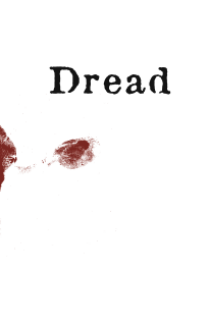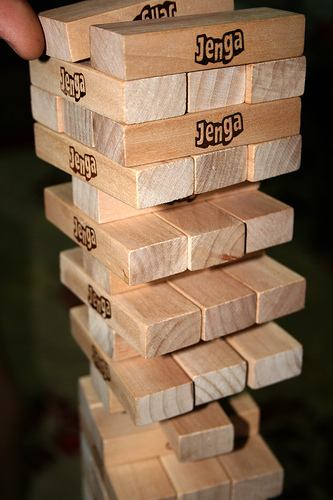You Should Be Playing…
Dread
Water drips a steady staccato somewhere in the darkness. By the dim glow seeping in through the windows of the basement, you can make out only a few shadows around you. The smell of dirt and rot cloys heavily in the air, and you can see the faint outline of a pile of dirt and broken concrete. The taste of the drink you sipped has gone stale in your mouth, mixed with a film of some chemical you cannot identify.
A sharp tug of your wrist gives a metallic scraping noise, and you can see the handcuffs and chain holding you to the wall glimmer slightly. If you can reach the window, you know you will live. Above, there is a creak of a footboard, and the sound of a heavy booted foot. In a few minutes, they will be back. You do not know what they intend, but if you can get your hand out of these cuffs, you will live. How many fingers must you break to slip the cuffs?
 Dread was written in 2005 by Epidiah Ravachol, and released that year by The Impossible Dream. It was nominated for ENnies in 2006 for Best Rules and Best Game, and while it did not win in either category, it was given the Gold Judge’s award for Innovation that year.
Dread was written in 2005 by Epidiah Ravachol, and released that year by The Impossible Dream. It was nominated for ENnies in 2006 for Best Rules and Best Game, and while it did not win in either category, it was given the Gold Judge’s award for Innovation that year.
Dread is a game of horror and suspense featuring a rules light system with a central mechanic that drives to the very heart of fear. Easily adaptable for nearly any suspense-related setting, the game itself is a must-own among horror gamers. The game retails for $24 USD and can be purchased through the Impossible Dream’s website directly. Electronic copies of the game can be purchased through DriveThruRPG for $12.
A Game, A Blueprint
Dread is a game system that is attached to a genre rather than a setting in particular. Perfect for a taut, tense thriller or a game of supernatural horror, Dread is easily adaptable to any game where fear is the sought after experience. Dread goes into detail to assist with this, offering several key suggestions on how to better run a horror game. It deconstructs many of the useful mechanisms for running horror in a tabletop environment and how to build suspense using narrative descriptions and key details. Dread examines the usage of both isolation and deception in horror storytelling, giving examples of particular types of isolation, the power of certain colors in description, and how not to overuse deceptive tactics.
It is the focus on how to run a horror and suspense based game that makes Dread a necessity for any horror Game Master. As far as types of stories go, horror is one of the most challenging styles to achieve. Maintaining an atmosphere of fear and suspense can be difficult for many GMs, and Dread acknowledges that not every gaming group or player will engage to horror. Dread goes into further detail on how to approach horror as a storytelling experience, and it discusses usage of madness, morality, and the supernatural in a game. Dread also discusses the proper use of mystery and gore, how to avoid desensitizing players to either, and when to draw the line. Beyond being a roleplaying game, Dread is a resource for GMs in how to create a compelling scary game.
Gameplay
Character creation in Dread leans strongly on the side of its minimalist system. In order to construct a character, players fill out a Questionnaire provided to them by the Host – Dread’s title for the Game Master. Dread discusses in each of its chapters how to use the Questionnaire to prime the players for the themes and elements a Host is planning on tapping into during the game. The Questionnaire is similar to a long answer test, with each question ideally being answered by one or two sentences. The Questionnaire is to be filled out completely and provided back to the Host with thought given to each of the answers. The Host then discusses with the players about any changes that may need to be made to fit the game and their characters.
The Questionnaire serves to inform both the player and the Host as to the nature of the character being brought to the table. Each of the questions should relate to the game, as well as provide the players room for the ambiguity where horror grows. A question such as, “When you have trouble sleeping, what pleasant memory do you focus on?” serves to provide the player with a better picture of their character’s personality, while also providing the Host something to draw from for particular imagery. The question, “What’s in your pockets?” provides a quick reference to the tools on hand for a character and what resources they can easily draw on. The question, “Where were you when the zombies attacked?” immediately provides the player with the insight that the game will be involving zombies, and includes the opportunity for involving other player or non-player characters.
Hosts are encouraged to include about 13 questions on their Questionnaire; less than that may not provide enough information and more may take too long to fully review. Once the Questionnaires are reviewed and finished, it is time to start the story.
Your World Sits Precariously
Dread’s central mechanic is both unique and perfect for its genre. Dispensing with the usual randomness of dice or the strict yes or no of many diceless games, Dread instead uses the mechanic of the Tower to handle action resolution. The Tower is a set of over fifty identical wooden rectangular blocks, stacked three to a level in alternating directions. When attempting an action where failure is possible or outside a character’s expertise, a player must make a Pull, removing a piece from the Tower with one hand and placing it on the top. Provided the Tower does not collapse from this, the action is successful. If the player chooses not to pull, or decides to stop in the middle of a pull, the action fails. If the Tower collapses, that character dies or is otherwise removed from the story. The more difficult the action, the more pulls it will require. Essentially, the central mechanic to Dread is effectively a game of Jenga. There are a couple of alternative methods, but the Tower method is arguably the best way to do play the game out. Luckily, if you do not have access to it, copies of Jenga are pretty inexpensive and easy to find.

If the Tower falls in Jenga, you lose the game. In Dread, you lose your life.
The use of the Tower in Dread is immeasurable in creating the atmosphere of fear and suspense. It serves as both a visual clue to the stakes at hand, and offers its own challenge of dexterity and control. Even a simple task can lead to a character’s destruction, and the choice is always there for a player to simply refuse to pull and accept the consequences of their situation rather than try to fight it.
Dread recommends keeping the Tower aside from the players, in a place unlikely to be disturbed by normal movements. Even if the player is not engaged in making a pull, if they cause the Tower to fall, it spells their destruction. The Tower stands for every opportunity and risk the players can take to work towards their goals, and the inevitability of their character’s demise.
Once the Tower collapses, it is rebuilt in its complete form, allowing for more options once again. In this, a player may even choose to simply knock the Tower over, sacrificing their character to help the others.
With the mechanic of the Tower, there is no randomness to bring the doom of a character. With careful preparation and building of atmosphere, a Host can weave a game of Dread into an experience that is as exciting as it is terrifying, and as compelling as it is disturbing. Like the lurid storytelling of horror’s masters, Dread builds its tension brick by brick until it teeters preciously above the players, ready to crash among them with the slightest push. In forcing that moment of causing their own destruction, whether by choice or accident, Dread crosses the line of player control over their character’s fate and places their destiny firmly in their own hands. Dread is a game of horror and suspense not just for the characters in the narrative, but for the players at the table as well.
And that is why you should be playing Dread.
David Gordon is a regular contributor to the site. A storyteller by trade and avowed tabletop veteran, he is always on the lookout for creative tabletop games. He can be reached at dave@cardboardrepublic.com.
You can discuss this article and more on our forums!
Photo Credits: Dread cover by The Impossible Dream; Jenga tower by sadeog.

